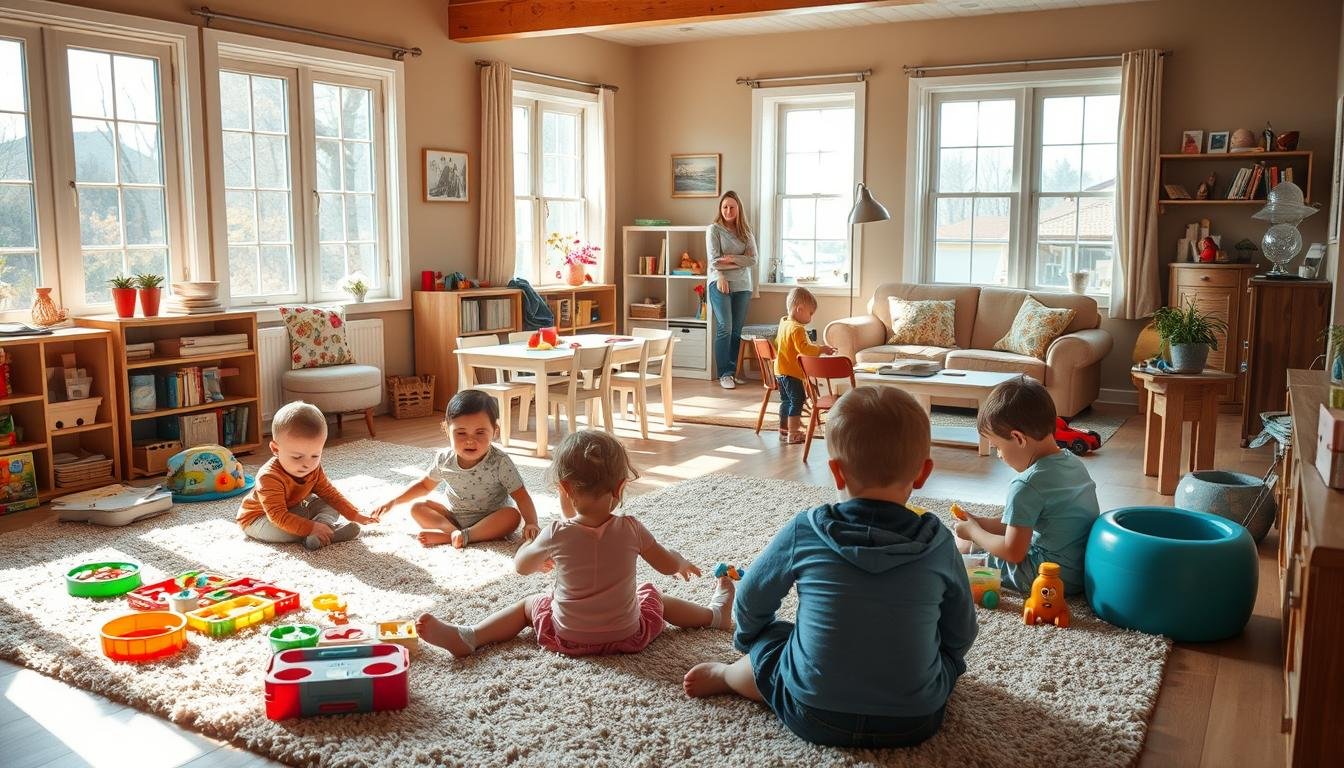
I still remember the mix of excitement and uncertainty I felt when arranging tiny chairs in my living room for the first time. What began as a heartfelt desire to create a safe, nurturing space for neighborhood kids grew into a fulfilling career that blends love for children with smart business practices.
Launching a child care service from home offers unique rewards. Unlike traditional ventures, it lets you shape young lives while maintaining low overhead costs. But success requires more than just crayons and patience – it demands a clear roadmap covering everything from licensing to financial planning.
Through trial and error, I discovered three non-negotiables: understanding local demand, creating detailed safety protocols, and building authentic connections with families. Resources like HomeCenter Management’s guide helped me navigate startup costs ($10k-$25k average) and state-specific regulations without overwhelm.
Key Takeaways
- Home-based child care combines personal fulfillment with business potential
- Detailed planning reduces risks and ensures regulatory compliance
- Market research identifies community needs and competitive advantages
- Licensing requirements vary significantly by state and county
- Startup costs typically range between $10,000-$25,000 initially
Understanding the Home Daycare Business Landscape
Mapping out my neighborhood’s childcare gaps became my first crucial step. I discovered three empty playgrounds and six packed centers during school pick-up hours – clear signs of unmet demand. This realization shaped how I positioned my services to stand out.
Evaluating Market Demand and Competition
Local parent Facebook groups revealed key patterns. One post from a nurse summed it up: “I need care by 5:30 AM – why does everything open at 7?” I tracked these pain points while comparing eight nearby providers:
| Factor | Competitor A | Competitor B | My Solution |
|---|---|---|---|
| Hours | 8 AM–5 PM | 7 AM–6 PM | 6 AM–7 PM |
| Age Range | 2–5 years | 1–6 years | 6 weeks–5 years |
| Enrichment | Basic | Music | STEM + Art |
California’s licensing rules capped my capacity at six children without an assistant. HomeCenter Management’s 2023 report notes:
“Providers who align services with neighborhood employment patterns see 40% faster enrollment growth.”
Identifying Your Ideal Clientele
Through trial runs with three families, I learned hospital staff valued flexible hours, while remote workers prioritized learning activities. My sweet spot became dual-income households needing:
- Extended care for shift workers
- Nutrient-focused meal plans
- Weekly progress updates
Government data shows 68% of licensed homes meet stricter safety requirements than unregulated options. This became my marketing edge when explaining value to cautious parents.
Creating a Robust Business Plan for Your Daycare

Crafting my business plan felt like building a safety net before the trapeze act of opening day. I discovered childcare ventures need financial clarity as much as educational vision. Three key elements shaped my strategy: realistic budgeting, smart funding choices, and ironclad legal protections.
Budgeting and Securing Funding
My initial $15,000 estimate covered safety upgrades and learning materials. Unexpected costs emerged quickly – $1,200 for fire-resistant curtains, $800 for allergy-friendly snacks. HomeCenter Management’s 2023 data shows:
“Providers who budget 20% extra for unforeseen expenses maintain smoother operations during their first year.”
Funding options fell into three categories:
- Personal savings (covered 40% of startup costs)
- SBA microloan ($8,000 at 6% APR)
- CCDF grant for low-income area providers
Defining Your Business and Legal Structure
Choosing between sole proprietorship and LLC kept me awake for weeks. My accountant’s advice cut through the fog: “Protect your home first.” The LLC route added $300 in filing fees but shielded personal assets when a parent slipped on wet stairs.
State-specific childcare regulations dictated staffing ratios and emergency drills. Partnering with a certified early education provider helped meet training requirements while boosting parent confidence. LegalZoom’s comparison tool clarified tax implications for different business structures.
how do i start a home daycare: Navigating Licensing, Regulations, and Safety
Walking through my first licensing inspection felt like preparing for the world’s most detailed pop quiz. California’s child care licensing checklist required 47 specific adjustments – from outlet covers to emergency evacuation maps. HomeCenter Management’s quality guide became my bible during this phase, helping me balance legal requirements with practical child development needs.
Understanding Licensing Requirements and Inspections
State inspectors flagged three issues I’d overlooked: missing fire extinguisher tags, improper medication storage, and a fence gap wider than 4 inches. Their feedback transformed my approach:
- Create color-coded zones for different activities
- Implement monthly fire drill documentation
- Use state-approved first aid kits
Implementing Essential Safety Measures at Home
Securing bookshelves to walls was just the start. I added:
- Tamper-proof cabinet locks on all cleaning supplies
- Non-slip mats under play equipment
- Emergency lighting for power outages
Regular safety audits now help me spot risks like worn carpet edges or fading emergency exit signs. As one inspector noted during my renewal: “Your commitment to continuous development sets the standard for home-based care.”
Setting Up a Child-Friendly Environment at Home

Transforming my living room into a vibrant learning space taught me that great design balances safety with imagination. The process required thoughtful planning – turning ordinary areas into zones that spark curiosity while meeting strict safety standards.
Home Modifications and Safety Proofing
My first step involved mapping out three distinct zones: a padded play area, quiet reading nook, and craft station. I used these modifications to maximize our property’s potential without major construction:
| Safety Feature | Before | After Modification |
|---|---|---|
| Flooring | Slippery hardwood | Interlocking foam mats |
| Storage | Open shelves | Locking toy cabinets |
| Lighting | Harsh overhead | Soft LED + natural light |
Child-proofing became an ongoing project. I secured bookshelves to wall studs, added safety gates at stairways, and installed tamper-resistant outlets. The right equipment choices made daily operations smoother – stackable cribs for naps, adjustable tables for art projects.
Choosing the best location within my home required balancing accessibility and supervision. Our sunroom became the main activity area, offering easy outdoor access while keeping noisy play away from sleeping infants. State guidelines dictated minimum square footage per child, influencing furniture arrangements.
Final touches included smoke detectors in every hallway and liability insurance covering playground injuries. These building upgrades not only met regulations but also gave parents confidence during tours. As one mom noted: “This feels like a second home, not an institution.”
Developing an Educational Program and Daily Activity Plan

Designing my curriculum felt like mixing art and science – blending colorful creativity with developmental milestones. My goal? To craft a program that sparks curiosity while building foundational skills through play.
Blending Learning Philosophies
I weave Montessori’s self-directed exploration with Reggio Emilia’s project-based learning. A typical early childhood session might include:
- Sensory bins for tactile discovery
- Nature collages using backyard finds
- Collaborative storytelling circles
Childcare Development Group’s 2024 report notes:
“Programs combining multiple educational approaches show 22% higher engagement in literacy activities.”
Structuring Daily Adventures
Mornings begin with energetic music sessions, followed by quiet reading time. Afternoons feature themed activities – last Thursday’s “Dinosaur Dig” combined counting games with fossil-making clay. I always leave space for spontaneous play, which experts say fuels childhood education breakthroughs.
My secret sauce? A flexible schedule that adapts to each child’s mood and growth stage. Parents receive weekly snapshots showing how block towers teach physics concepts, or how sharing toys builds emotional intelligence. It’s proof that early childhood education thrives when learning feels like discovery.
Managing the Business Side: Insurance, Billing, and Marketing

Balancing spreadsheets and storytime taught me that successful childcare requires equal parts heart and hustle. Protecting my daycare business meant building financial safeguards while creating genuine connections with families.
Securing Insurance and Handling Financials
My insurance agent recommended three essential policies after reviewing care licensing requirements:
| Coverage Type | Protection Scope | Annual Cost |
|---|---|---|
| Liability | Accidents/injuries | $1,200 |
| Property | Equipment damage | $800 |
| Business Interruption | Closure emergencies | $450 |
Childcare Financial Associates notes:
“73% of home providers using automated billing software reduce payment delays by 15+ days.”
I adopted cloud-based tools for invoicing and tax tracking – a game-changer during tax season.
Effective Marketing Strategies to Attract Families
Building trust started with showcasing our care center’s unique value:
- Professional website with virtual tour
- Local parent forums participation
- Referral bonuses for enrolled families
Social media became my secret weapon. Weekly posts featuring art projects and meal prep videos helped parents visualize their child’s day. Traditional methods like library flyers still bring 20% of new inquiries.
Tracking results revealed what works:
| Channel | Cost/Month | Enrollment Rate |
|---|---|---|
| Facebook Ads | $150 | 35% |
| Local Directories | $75 | 28% |
| Community Events | $50 | 17% |
This multi-channel approach keeps our daycare center visible without breaking the budget.
Hiring and Training Qualified Childcare Providers
Building my childcare team felt like assembling puzzle pieces where each member’s passion perfectly fit our mission. Quality family child care thrives when providers bring both expertise and genuine enthusiasm to their work. I prioritized candidates who saw playtime as learning time and tantrums as teaching moments.
Recruiting Passionate Staff and Assistants
My hiring process focused on three non-negotiables: patience, creativity, and safety awareness. I used role-playing scenarios during interviews to gauge how applicants handled conflicts between children. The best candidates often revealed themselves through subtle actions – like kneeling to a toddler’s eye level during introductions.
| Candidate Quality | Basic Requirement | Exceptional Trait |
|---|---|---|
| Experience | 1 year in childcare | Special needs training |
| Communication | Clear parent updates | Child-friendly vocabulary |
| Adaptability | Follows schedules | Improves activities |
Ongoing Training and Certification Requirements
State mandates require 15 annual training hours, but our team averages 30+. We rotate between CPR refreshers and emerging trends like sensory integration techniques. As one workshop leader noted:
“Family child care providers who invest in professional growth see 50% fewer staff turnover issues.”
Certifications became our credibility anchors. Every team member holds:
- Pediatric First Aid/CPR
- Food handling permits
- Early childhood education units
Monthly peer coaching sessions keep our child care center sharp. Last quarter, we practiced de-escalation strategies that reduced timeout incidents by 40%. This commitment to growth helps parents trust we’re nurturing their children’s potential – not just watching the clock.
Utilizing Technology and Online Listings to Grow Your Daycare
My website became my 24/7 salesperson, showcasing colorful play areas and parent testimonials while I slept. This digital storefront communicates our commitment to creative learning and safety standards better than any brochure.
Building a Professional Website and Online Presence
Three elements transformed my site into an enrollment magnet: clear information about programs, instant inquiry forms, and a virtual tour. I prioritized mobile-friendly design after learning 83% of parents research childcare options on phones during commutes.
Local directories boosted visibility without expensive ads. Listing on platforms like Care.com and Yelp brought 12 new families last quarter. Social media became our community hub – weekly posts featuring art projects and meal prep videos build trust with prospective clients.
“Providers updating their Google Business profiles weekly see 37% more website clicks,” notes Childcare Marketing Pros’ 2024 report.
SEO strategies made us discoverable. By targeting phrases like “flexible childcare near me” and optimizing page speeds, organic search traffic doubled in six months. Regular blog posts answering common parent questions keep our information fresh and relevant.
| Traffic Source | Before SEO | After SEO |
|---|---|---|
| Google Searches | 15% | 42% |
| Social Media | 30% | 35% |
| Direct Visits | 55% | 23% |
Automated tools streamline operations while impressing tech-savvy families. Digital check-in systems and photo-sharing apps reduced administrative work by 10 hours weekly. Parents appreciate real-time updates about their child’s day – it’s turned our daycare into a trusted partner rather than just a service.
Conclusion
Seeing the first child beam with pride after tying their shoes reminded me why this journey matters. Launching a care business from your property blends heart-led service with smart strategy – when done right.
Every step counts. From licensing paperwork to insurance policies, preparation builds trust with families. I learned that success stems from balancing regulations with creativity, turning your space into a haven where kids thrive.
Parents seek partners who prioritize safety and growth. Regular drills, nutritious meals, and transparent communication became my signature. These details transform a house into a professional care environment that stands out.
For fellow providers: stay adaptable. Market shifts and new business tools emerge constantly. What remains timeless? The joy of shaping young minds and supporting parents through life’s busy days.
Build your venture with care, and excellence follows. Families deserve spaces where every day sparks discovery – yours could be that place.

Leave a Reply